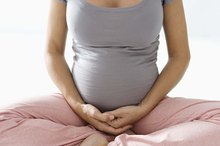Can Exercising Stop Menstrual Cramps?
Menstrual cramps top the list of reasons that girls miss school and women miss work, according to University of California San Diego's Student Health Services. Pain may occur a few days before your period begins and becomes less severe as menstrual bleeding comes to an end. Over-the-counter pain relievers such as ibuprofen are common remedies for painful menstrual cramps. However, exercise may also provide relief.
The Causes of Pain
Pain associated with menstruation is known medically as dysmenorrhea. In primary dysmenorrhea, pain is usually due to increased levels of hormones called prostaglandins, which trigger contractions in the uterine and intestinal walls. Secondary dysmenorrhea refers to menstrual pain that begins to develop after your periods have been normal and is usually caused by abnormalities in the pelvic organs or uterus, such as fibroids or ovarian cysts. It may also be related to stress, anxiety or a sexually transmitted disease.
- Pain associated with menstruation is known medically as dysmenorrhea.
- Secondary dysmenorrhea refers to menstrual pain that begins to develop after your periods have been normal and is usually caused by abnormalities in the pelvic organs or uterus, such as fibroids or ovarian cysts.
Cramp-Relieving Effect
Menstrual Cramps & Cranberry Juice
Learn More
Exercise can help relieve menstrual cramps in a few ways. It increases blood circulation, which helps cramps to go away. Menstrual cramps are also made worse by stress; exercise is a well-known, natural way to lower stress. In a study published in the “Journal of Research in Health Science” in 2006, Iranian researchers found that exercise helped decrease the duration and severity of primary dysmenorrhea in high school girls. It also reduced the girls’ use of sedative medications.
- Exercise can help relieve menstrual cramps in a few ways.
- Menstrual cramps are also made worse by stress; exercise is a well-known, natural way to lower stress.
Type and Amount of Exercise
When you’re in pain, the last thing you want to do is strenuous or vigorous exercise. Choose gentle, low-impact aerobic exercises, such as walking or swimming at a slow pace. Exercises that rock your pelvis, such as pelvic tilts, and stress-reducing activities, such as yoga and tai chi, might also provide relief. However, avoid doing yoga inversions while on your period. Ideally, you should get at least 30 minutes of aerobic exercise most days of the week. If this seems like a stretch when you’re suffering with menstrual cramps, break those exercise sessions into three 10-minute bouts.
- When you’re in pain, the last thing you want to do is strenuous or vigorous exercise.
- Ideally, you should get at least 30 minutes of aerobic exercise most days of the week.
Complementary Relief for Cramps
Midol Alternatives
Learn More
To get quicker relief, use a combination of remedies instead of just exercise alone. Other non-drug remedies for menstrual cramps include taking a warm bath, gentle abdominal massages and placing a warm heating pad over your abdomen. Taking extra vitamins and minerals, such as vitamins D and E, calcium, omega-3 essential fatty acid supplements and a three-day course of magnesium may also provide some relief. Right before and during menstruation, drink lots of fluids, eat iron-rich foods such as lean meat, green leafy vegetables and whole grains and limit your intake of caffeine.
- To get quicker relief, use a combination of remedies instead of just exercise alone.
- Other non-drug remedies for menstrual cramps include taking a warm bath, gentle abdominal massages and placing a warm heating pad over your abdomen.
See Your Doctor First
If you have not been active for a while or have a medical condition such as heart disease, diabetes or arthritis, consult your doctor before starting to exercise to relieve menstrual cramps. Also seek medical attention if you've suddenly started to develop menstrual cramps after years of normal periods as they may signal other health problems, such as fibroids.
Related Articles
References
- University of Maryland Medical Center: Menstrual Pain
- Barcikowska Z, Rajkowska-Labon E, Grzybowska ME, Hansdorfer-Korzon R, Zorena K. Inflammatory markers in dysmenorrhea and therapeutic options. Int J Environ Res Public Health. 2020;17(4):1191. doi:10.3390/ijerph17041191
- NHS. Period pain. Updated August 7, 2019.
- Kids Health from Nemours. Talking to your child about periods. Updated October 2018.
- Medline Plus. Period pain.
- Johns Hopkins Medicine. Dysmenorrhea.
- Mayo Clinic. Menstrual cramps.
- Johns Hopkins Medicine. Dysmenorrhea.
- University of Utah Health. Period pain: When to go to the doctor. Updated October 20, 2017.
- Women's Health Concern. Period pain. Updated November 2019.
- American College of Obstetricians and Gynecologists. Dysmenorrhea: Painful periods.
Writer Bio
Kay Uzoma has been writing professionally since 1999. Her work has appeared in "Reader’s Digest," "Balance," pharmaceutical and natural health newsletters and on websites such as QualityHealth.com. She is a former editor for a national Canadian magazine and holds a Bachelor of Arts in political science from York University.









